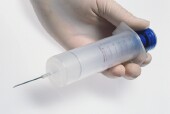
WEDNESDAY, May 29 (HealthDay News) — Since the start of last year’s outbreak of fungal meningitis cases linked to tainted steroid injections, federal health officials have recommended three to six months of antifungal therapy to combat potentially fatal infections.
But health officials reported Wednesday that an 80-year-old man received four-and-a-half months of antifungal therapy and seemed cured, only to suffer a relapse that put him back in the hospital.
Writing in the May 29 online edition of the New England Journal of Medicine, doctors from the U.S. Centers for Disease Control and Prevention said it’s not clear if the current treatment guidelines are adequate. “Some patients with central nervous system infection may require prolonged antifungal therapy owing to the chronic nature of fungal diseases and the difficulty in maintaining adequate drug concentrations” in the cerebral spinal fluid, they wrote.
The CDC doctors said they weren’t ready to change treatment recommendations at this point. But they continue to monitor clinical reports on the progress of patients treated for fungal meningitis tied to the faulty injections that were originally given for back pain.
The infections were caused by a fungus called Exserohilum rostratum, which is basically a common black mold that contaminated vials of steroids produced by the now-shuttered New England Compounding Center in Massachusetts.
Since the first reports back in September, the outbreak has sickened 741 people in 20 states and killed 55.
The CDC report released Wednesday said the 80-year-old man received a contaminated steroid injection on Sept. 12. He arrived at an unnamed hospital on Oct. 4 complaining of a headache and neck pain. A test of his cerebrospinal fluid showed a white cell count of 119 cells per milliliter of fluid.
After being treated with the antifungal medication voriconazole, the man’s white cell count had fallen to 5 white cells per milliliter of fluid by Jan. 11. The drug therapy was discontinued Feb. 19, four-and-a-half months after it had started.
But three weeks later, on March 11, the man was back at the hospital emergency department with a headache and neck pain. His white cell count had soared to 2,075 per milliliter of spinal fluid, and he tested positive for E. rostratum.
Therapy with voriconazole was restarted, and the patient was discharged four days later. When a health department worker visited his home two weeks later, he seemed better, reporting only fatigue, the CDC officials said.
In their letter to the journal, Dr. Rachel M. Smith and colleagues said the agency “is aware of patients who have not had a relapse of disease after three or four months of antifungal treatment, [but] the risk of relapse should be considered when deciding whether to discontinue antifungal therapy. Other factors include the severity of infection, the subsequent response to antifungal treatment, and the side effects of long-term therapy.”
The doctors also recommended continued monitoring of patients by health-care experts.
Earlier this month, CDC researchers reported that the tainted steroid injections caused many less-lethal infections, more than half of them in Michigan. As of the first week of May, spinal or near-spinal infections without meningitis had affected 320 people nationwide, with 52 percent of those cases in Michigan.
“Michigan has reported the highest percentage of cases even though we received only 13 percent of the contaminated drug that was shipped nationally,” said the report’s co-author, Mawuli Nyaku, an epidemic intelligence service officer with the CDC.
The reasons for that disproportionate rate aren’t clear, Nyaku said. Nor is it known if more cases will surface.
“We are not out of the woods yet,” Nyaku said. “We have never seen anything like this before.”
Because the time from injection to symptoms of illness isn’t really known, more people who received the tainted drug may develop infections, Nyaku said. “Physicians are seeing patients who have developed infections 200 days after receipt of injection,” he said. He urged doctors to consider the possibility of infection in anyone who received the injections.
The infections are localized, concentrated at or near the injection site, and have led to abscesses, pain and some joint infections that necessitated joint replacement, Nyaku explained.
Nyaku said one reason for the high number of cases in Michigan is that St. Joseph Mercy Hospital in Ann Arbor saw the most patients with the infection in the country. To help identify new cases, the hospital offered MRIs to anybody who had been exposed to the contaminated steroids. “In doing so they identified additional cases, which contributed to the high number,” Nyaku said.
Another possible explanation, Nyaku said, is that more than 2,000 of the 17,000 vials of tainted drugs were shipped to Michigan. And one of the lots shipped to the state appeared to cause more infections than the other two contaminated lots, he said.
Some patients who stopped therapy also have seen their illness return, he added.
More information
For more on fungal infections, visit the U.S. Centers for Disease Control and Prevention.

